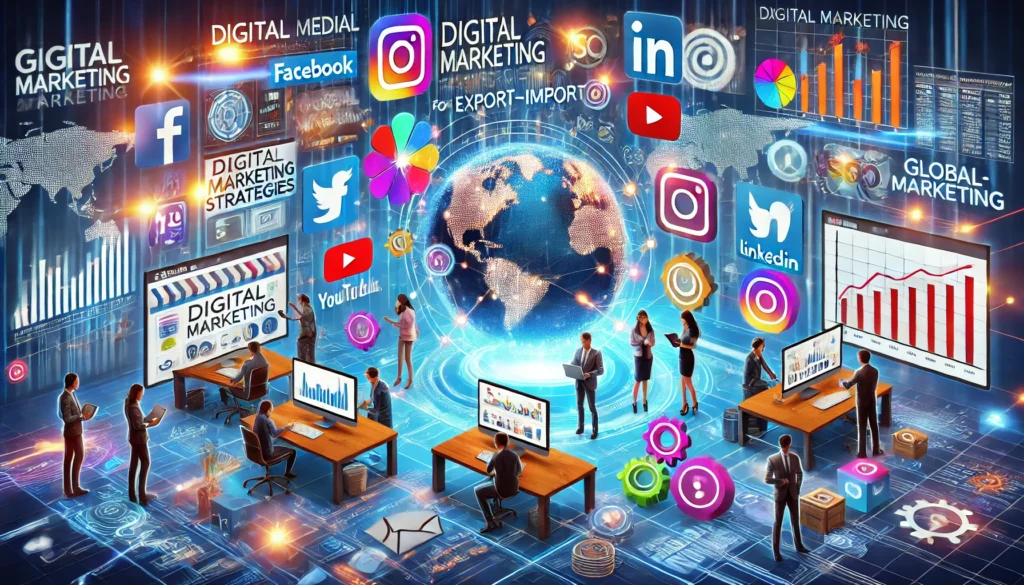Table of Contents
ToggleDigital Marketing Strategies for Export-Import Businesses
Introduction
In today’s globalized world, digital marketing plays a crucial role in the success of export-import businesses. Leveraging digital platforms helps businesses reach international buyers, generate leads, and build a strong global brand presence. This blog explores effective digital marketing strategies tailored for export-import businesses to expand their market reach and drive sales.

Importance of Digital Marketing in Export-Import Business
Global Reach: Digital marketing allows exporters and importers to connect with buyers worldwide.
Cost-Effectiveness: Online marketing is more affordable than traditional methods such as trade shows and print advertising.
Lead Generation: Digital platforms help businesses attract potential customers and convert leads into sales.
Brand Visibility: Establishing a strong online presence builds credibility and trust with international clients.
Data-Driven Decisions: Digital marketing tools provide insights into customer behavior, enabling businesses to refine strategies.
Key Digital Marketing Strategies for Export-Import Businesses
1. Build a Professional Website
A website acts as a virtual storefront for an export-import business. Key features include:
SEO-Optimized Content: Use relevant keywords to rank higher in search results.
Multilingual Support: Cater to international audiences with translations.
Mobile Optimization: Ensure a seamless experience across devices.
Product Listings and Certifications: Showcase products, specifications, and compliance certifications.
2. Search Engine Optimization (SEO)
SEO improves a website’s visibility in search engines. Key aspects include:
On-Page SEO: Optimize meta titles, descriptions, and headers.
Off-Page SEO: Build backlinks from industry directories and trade websites.
Technical SEO: Improve website speed, navigation, and user experience.
Local SEO: Optimize for country-specific searches and Google My Business.
3. Social Media Marketing
Social media platforms help businesses engage with international clients. Best practices include:
LinkedIn: Connect with B2B buyers, exporters, and trade associations.
Facebook & Instagram: Showcase products, success stories, and customer testimonials.
YouTube: Create educational videos on product usage and industry insights.
Twitter/X: Stay updated on trade news and network with industry leaders.
4. Content Marketing
Publishing valuable content attracts and educates potential buyers. Key content strategies include:
Blogging: Write articles on export-import regulations, industry trends, and product benefits.
Case Studies: Showcase successful international deals and partnerships.
Whitepapers & E-books: Offer in-depth market insights and business guides.
Infographics: Visualize data on trade statistics and supply chain logistics.
5. Email Marketing
Email campaigns nurture leads and maintain relationships with clients. Effective email strategies include:
Personalized Emails: Address prospects by name and tailor content to their interests.
Newsletters: Share industry updates, trade tips, and new product launches.
Follow-Ups: Send automated emails to potential buyers who showed interest.
Lead Magnets: Offer free reports or consultation in exchange for email sign-ups.
6. Online Advertising (PPC & Display Ads)
Paid advertising accelerates lead generation and brand awareness. Effective PPC strategies include:
Google Ads: Target international buyers searching for specific products.
Facebook & LinkedIn Ads: Run B2B campaigns for niche markets.
Retargeting Ads: Re-engage visitors who previously interacted with the website.
Geo-Targeting: Focus on specific countries or regions with high demand.
7. Trade Directories & B2B Platforms
Listing products on trade portals increases visibility among global buyers. Popular platforms include:
Alibaba
IndiaMART
TradeIndia
GlobalSources
ExportHub
8. Video Marketing
Videos boost engagement and credibility. Effective video strategies include:
Product Demonstrations: Showcase features and benefits.
Client Testimonials: Build trust with authentic feedback.
Behind-the-Scenes Videos: Highlight production, packaging, and logistics.
Live Webinars: Educate prospects on industry trends and compliance.
9. Influencer & Partner Collaborations
Partnering with industry influencers and trade associations enhances credibility. Methods include:
Guest Blogging: Collaborate with trade publications.
Webinar Co-Hosting: Partner with industry experts for knowledge-sharing sessions.
Affiliate Marketing: Offer commissions to partners promoting products.
10. Analytics and Performance Tracking
Measuring digital marketing efforts ensures optimization and better ROI. Useful tools include:
Google Analytics: Track website traffic and user behavior.
Google Search Console: Monitor keyword rankings and SEO performance.
Facebook Insights & LinkedIn Analytics: Evaluate social media engagement.
Email Campaign Metrics: Assess open rates and conversion rates.
Conclusion
Digital marketing is a powerful tool for export-import businesses to expand globally, attract buyers, and stay competitive. A well-planned strategy incorporating SEO, social media, content marketing, and online advertising can significantly boost sales and market presence. By leveraging data-driven insights, businesses can refine their digital marketing efforts and achieve long-term success in international trade.
